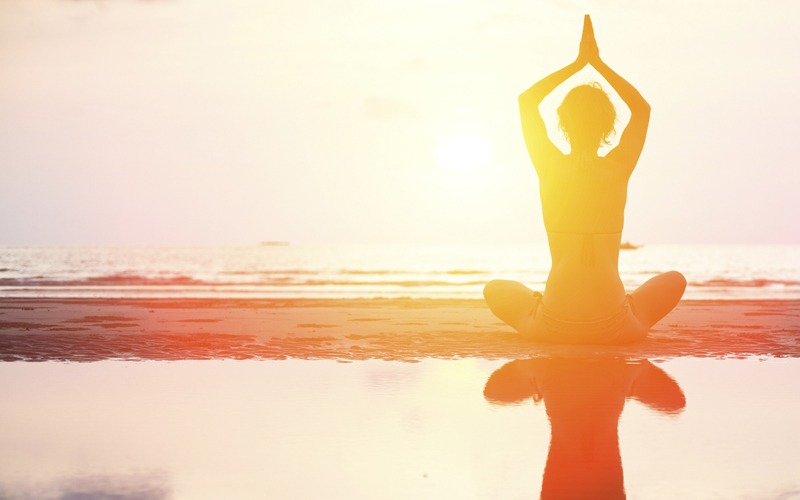
by guest bloggers Jeff Perlman and Holly Walck Kostura
Ayurveda reveals to us that there are seasons each year defined by the three doshas: vata (fall and early winter), kapha (winter and early spring), and pitta (late spring and summer). Each dosha goes through three stages each year with the changes of the seasons, temperature, and weather.
The pitta dosha is associated with fire and water and has the qualities of being hot, wet, light, and mobile. This dosha accumulates during the warmth of the late spring, is at its height during the heat of the summer, and then alleviates during the cooler fall months.
Fire is predominant with the pitta dosha and relates to transformation, metabolism, and digestion. These qualities govern physical digestion and assimilation, control the transformation and assimilation of the senses, and provide the capacity to perceive reality and the ability to understand.
Physically, pitta people tend to feel warm, have oily skin, have penetrating eyes and sharp features; their weight is moderate and their musculature good. When out of balance, they can contract diarrhea, infections, and skin rashes with liver and blood weaknesses.
The pitta personality tends to be highly focused, competitive, capable, courageous, and energetic; they are clear and concise communicators and enjoy solving problems. When under stress, they dig in their heels, can become intense, and speak sharply. Emotionally, they can have a tendency toward anger, resentment, and jealousy.
When out of balance, this dosha becomes competitive, quarrelsome, dominating, impatient, resentful and intolerant. This dosha’s seat is in the eyes, lower abdominal area, and the blood. Many pitta-related imbalances occur through inflammation, infection, and irritation in these systems.
Pitta-Balancing Ayurvedic Actions for the Dog Days of Summer
Since the doshas are treated with opposite actions, it’s especially important during the summer months that pitta remain cool, calm, and peaceful and use the qualities of coolness, heaviness, and dryness to help stay in balance.
Good food choices for this season are the sweet, bitter, and astringent tastes. Use cooling spices like fennel, coriander, cumin, tarragon, and mint. Eat sweet summer fruits, including apricots, peaches, sweet berries, and melons, along with milk, cottage cheese, rice, beans, and vegetables like broccoli, cauliflower, cucumber, summer squashes, kale, and lettuces.
Asana practice should be done early in the morning and include poses that promote coolness, ease, and lightness while releasing heat in the small intestine, central abdomen, and liver. Specifically recommended are all inversions, standing and seated twists, and forward bends. Pranayama should be cooling. Exhaling through the mouth occasionally to release heat. Supine Ujjayi (Ocean Breath), Shitali, Left-Nostril Breathing, and Bhramari are best.
Daily self-massage using coconut or sunflower oil before showering is cooling, nourishing, and grounding. If you use essential oils, choose rose, sandalwood, or lavender.
Wear clothing of light texture. Preferred colors are white, blue, and green. Stay away from red and yellow, which promote heat. Enjoy regular, relaxing, peaceful walks in nature to calm the inherent intensity experienced during this time of year.
Pitta-Balancing Yoga Sequence for the Dog Days of Summer
Try the following sequence to help keep yourself in balance throughout pitta season.
Action: Contract the abdomen, loosen the hips, and open the chest.
Reflection: How much mental heat do I generate while practicing? Can I practice skillfully and use props mindfully to help me achieve the actions above?
Devotion: “Only God is perfect.” —B.K.S. Iyengar
Sequence:
1. Downward-facing Hero’s Pose (Adho Mukha Virasana)
2. Downward-facing Dog Pose (Adho Mukha Svanasana)
3. Intense Stretch Pose (Wide-legged Uttanasana)
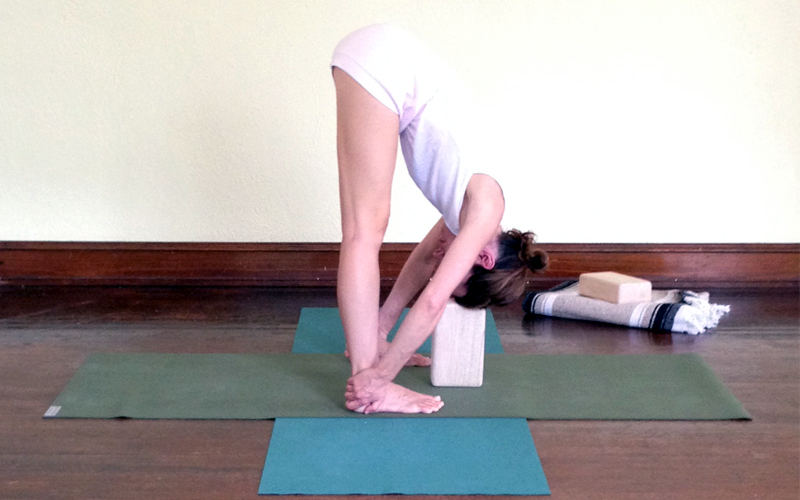
Notes for best practice:
- All of these poses should be done with support under the head.
- From Intense Stretch Pose, walk back to Downward-facing Dog Pose again and support the head, then come back to Intense Stretch Pose.
- Come up by keeping the head down.
4. Legs Spread Wide Apart and Fully Extended Pose (Prasarita Padottanasana I)
- In the concave stage, raise the heels up while keeping the upper thighs pressed back and turn the heels out.
- Repeat and see what changes come to the hamstrings and spinal muscles.
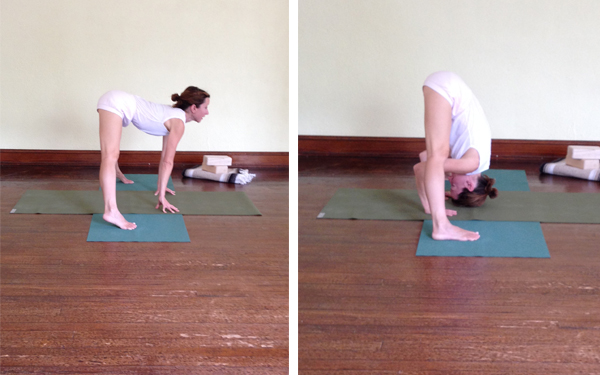
5. Seated Angle Pose (Upavistha Konasana)
- Practice both the seated and concave stages found here.
6. Sideways Seated-Angle Pose (Parsva Upavistha Konasana)
- From Seated Angle Pose, turn to the right. Press the left thigh down into the floor and extend strongly from the inner groin out through the inner heel.
- While maintaining the extension of the anterior spine, take your left hand to your outer right foot or shin or to a chair.
- Use the exhalation to bring the center of your abdomen, chest, forehead, and leg together. See that both your legs and spine are stretched fully.
- Repeat on the left and then again on both sides.
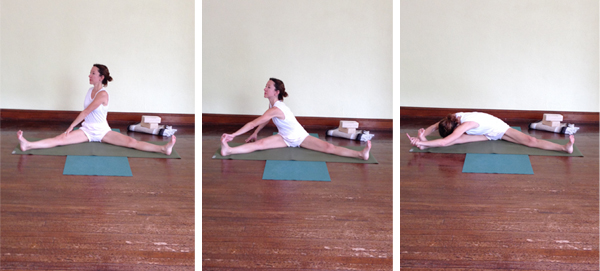
7. Tortoise Pose (Kurmasana)
- Sit on a blanket with both knees bent. Turn to the left and extend the spine forward and downward, bringing the back of the left armpit below the inner left knee. Join the left side of the trunk and the left inner thigh (Figure 1).
- Repeat on the left side.
- Go as far as you did in the first stage again on the right side and turn the left arm in and extend the arm all the way out to the left side.
- Repeat on the right side (Figure 2).
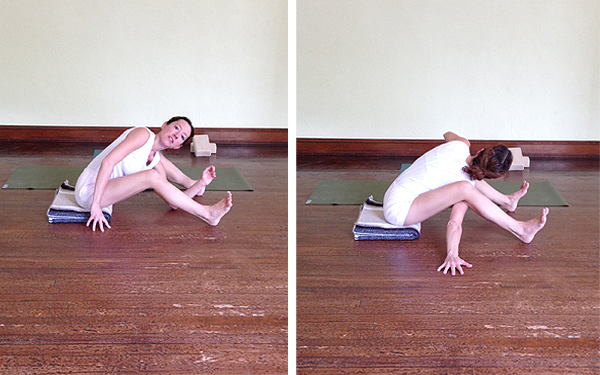
- Now turn to the left and go as far as you did in the second stage and turn to the right, extend forward and downward, and then duck under your right leg.
- Inhale and move the bottom ribs, the sternum, and the collarbones forward toward the wall in front of you.
- Exhale, roll the thighs from the outside in, and extend the legs by reaching from the inner calves to the inner ankles and from the inner ankles to the inner heels.
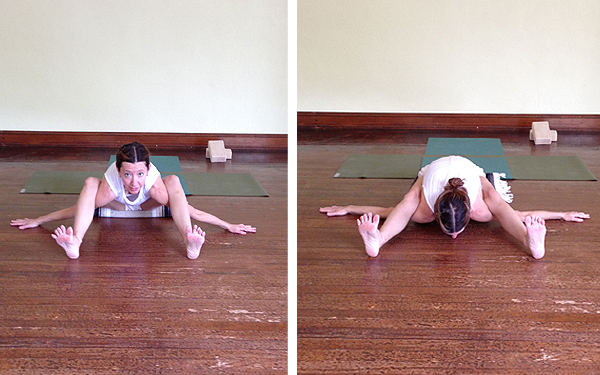
8. Reclining Cross-Legs Pose (Supta Swastikasana)
- Lie down even on your back; bend your knees into your chest and cross your shins into Reclining Cross-Legs Pose.
- Hold the outer edges of your feet and use the hands to turn your feet so that the soles of your feet face the backs of your thighs.
- Lift your pubic bone to your sternum as you release your legs to the floor. Lengthen from the inner groins to the inner knees.
- Raise your arms overhead and lift your chest up toward your head.
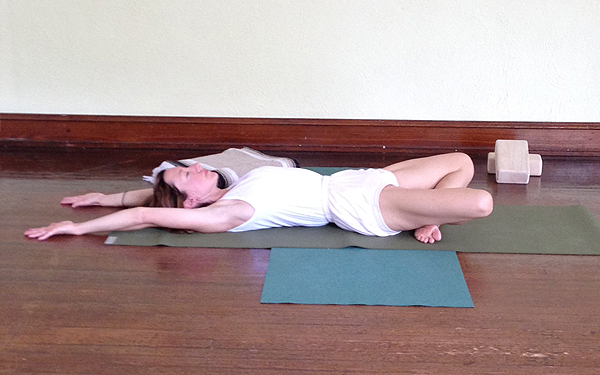
9. Legs-up-the-Wall Pose (Viparita Karani)
- Hold for 5 to 10 minutes and then come out and lie flat on your back for a few minutes.
 Holly Walck Kostura uses the healing practices of Ayurveda and Iyengar Yoga to secure her to the core of her being. Her bachelor’s degree in nursing, combined with a certification in Iyengar Yoga, give her the ability to approach her students from a place of wholeness and infuse her yoga classes with a unique flavor. www.yogawithholly.com
Holly Walck Kostura uses the healing practices of Ayurveda and Iyengar Yoga to secure her to the core of her being. Her bachelor’s degree in nursing, combined with a certification in Iyengar Yoga, give her the ability to approach her students from a place of wholeness and infuse her yoga classes with a unique flavor. www.yogawithholly.com
 Jeff Perlman is a clinical Ayurvedic and panchakarma specialist, with advanced accreditation in pulse diagnosis and marma therapy; a professional member of the National Ayurvedic Medical Association; a certified massage therapist; a certified Iyengar Yoga instructor; and a Cordon Bleu chef. Find him online at threeseasonsayurveda.com.
Jeff Perlman is a clinical Ayurvedic and panchakarma specialist, with advanced accreditation in pulse diagnosis and marma therapy; a professional member of the National Ayurvedic Medical Association; a certified massage therapist; a certified Iyengar Yoga instructor; and a Cordon Bleu chef. Find him online at threeseasonsayurveda.com.




No comments yet.